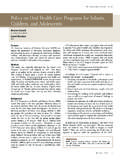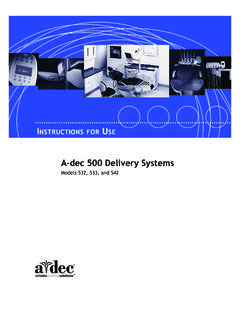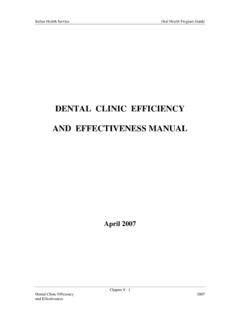Transcription of Guideline on Use of Anesthesia Personnel in the ...
1 228 CLINICAL PRACTICE GUIDELINESREFERENCE MANUAL V 37 / NO 6 15 / 16 PurposeThe American Academy of Pediatric Dentistry (AAPD) recog- nizes that there are pediatric dental patients for whom routine dental care using nonpharmacologic behavior guidance tech- niques is not a viable The AAPD intends this Guideline to assist the dental practitioner who elects to use Anesthesia Personnel for the administration of deep sedation/general Anesthesia for pediatric dental patients in a dental office or other facility outside of an accredited hospital or surgicenter. This document discusses Personnel , facilities, documentation, and quality assurance mechanisms necessary to provide optimal and responsible patient revision of this Guideline is based upon a review of current dental and medical literature pertaining to deep sedation/ general Anesthesia of dental patients, including a systematic literature search of the MEDLINE/PubMed electronic data-base with the following parameters: Terms: office-based general Anesthesia , pediatric sedation, deep sedation, sleep den- tistry, and dental sedation; Fields: all.
2 Limits: within the last 10 years, humans, all children from birth through age 18, English, clinical trials, and literature reviews. The search returned 62 articles; the reviewers agreed upon the inclusion of 10 articles that met the defined criteria. When data did not appear sufficient or were inconclusive, recommendations were based upon expert and/or consensus opinion by ex- perienced researchers and clinicians. BackgroundPediatric dentists seek to provide oral health care to infants, children, adolescents, and persons with special health care needs in a manner that promotes excellence in quality of care and concurrently induces a positive attitude in the patient toward dental treatment.
3 Behavior guidance techniques have allowed most pediatric dental patients to receive treatment in the dental office with minimal discomfort and without expressed fear. Minimal or moderate sedation has allowed others who are less compliant to receive treatment. There are some children and special needs patients with extensive treatment needs, acute situational anxiety, uncooperative age-appropriate be- havior, immature cognitive functioning, disabilities, or medical conditions who require deep sedation/general Anesthesia to receive dental treatment in a safe and humane fashion. Access to hospital-based Anesthesia services may be limited for a variety of reasons, including restriction of coverage of by third party Pediatric dentists and others who treat children can provide for the administration of deep sedation/general Anesthesia by utilizing properly trained individuals in their offices or other facilities outside of the traditional surgical setting.
4 Deep sedation/general Anesthesia in the dental office can provide benefits for the patient and the dental team. Access to care may be improved. The treatment may be scheduled more easily and efficiently. Facility charges and administrative proce-dures may be less than those associated with a surgical center. Complex or lengthy treatment can be provided comfortably while minimizing patient memory of the dental procedure. Movement by the patient is decreased, and the quality of care may be improved. The dentist can use his/her customary in-office delivery system with access to trained auxiliary per- sonnel, supplemental equipment, instrumentation, or supplies should the need arise.
5 The use of Anesthesia Personnel to administer deep sedation/general Anesthesia in the pediatric dental population is an accepted treatment The AAPD supports the provision of deep sedation/general Anesthesia when clinical indications have been met and additional properly-trained and credentialed Personnel and appropriate facilities are ,3,7 In many cases, the patient may be treated in an Guideline on Use of Anesthesia Personnel in the Administration of Office-based Deep Sedation/ General Anesthesia to the Pediatric dental Patient Originating Committee Clinical Affairs Committee Sedation and General Anesthesia SubcommitteeReview CouncilCouncil on Clinical AffairsAdopted 2001 Revised2005, 2007, 2009, 2012 AMERICAN ACADEMY OF PEDIATRIC DENTISTRY CLINICAL PRACTICE GUIDELINES 229appropriate out-patient facility (including the dental office) because the extensive medical resources of a hospital are not necessary.
6 RecommendationsClinicians may consider using deep sedation or general anes- thesia in the office to facilitate the provision of oral health care. Practitioners choosing to use these modalities must be familiar with their patient s medical history and emergency procedures, as well as the regulatory and professional liability insurance requirements needed to provide this level of phar- macologic behavior management. This Guideline does not supersede, nor is it to be used in deference to, federal, state, and local creden-tialing and licensure laws, regulations, and deep sedation/general Anesthesia techniques re- quire at least three individuals. The Anesthesia care provider s responsibilities are to administer drugs or direct their adminis-tration and to observe constantly the patient s vital signs, airway patency, cardiovascular and neurological status, and adequacy of In addition to the Anesthesia care provider, the operating dentist and other staff shall be trained in emergency procedures.
7 It is the obligation of treating practitioners, when employ-ing Anesthesia Personnel to administer deep sedation/general Anesthesia , to verify their credentials and experience. The Anesthesia care provider must be a licensed dental and/or medical practitioner with appropriate and current state certification for deep sedation/general Anesthesia . The Anesthesia care provider must have completed a one- or two-year dental Anesthesia residency or its equivalent, as approved by the American dental Association (ADA), and/or medical Anesthesia residency, as approved by the American Medical Association (AMA). The Anesthesia care provider currently must be licensed by and in compliance with the laws of the state in which he/she practices.
8 Laws vary from state to state and may supercede any portion of this document. If state law permits a certified registered nurse anesthetist or Anesthesia assistant to function under the supervision of a dentist, the dentist is required to have completed train- ing in deep sedation/general Anesthesia and be licensed or permitted, as appropriate to state law. The dentist and Anesthesia care provider must be compliant with the American Academy of Pediatrics/AAPD s Guideline on Monitoring and Management of Pediatric Patients During and After Sedation for Diagnostic and Therapeutic Procedures3 or other appropriate Guideline (s) of the ADA, AMA, and their recognized specialties. The recommendations in this document may be exceeded at any time if the change involves improved safety and is supported by currently-accepted practice and/or is evidence-based.
9 The dentist and Anesthesia Personnel must work together to enhance patient safety. Effective communication is essential. The dentist introduces the concept of deep sedation/general Anesthesia to the parent and provides appropriate preoperative instructions and informational materials. The dentist or his/her designee coordinates medical consultations when necessary. The Anesthesia care provider explains potential risks and obtains informed consent for sedation/ Anesthesia . Office staff should understand their additional responsibilities and special consid-erations (eg, loss of protective reflexes) associated with office- based deep sedation/general Anesthesia . Advanced training in recognition and management of pediatric emergencies is critical in providing safe sedation and anesthetic care.
10 There must be one person available whose only responsibilities are to constantly observe the patient s vital signs, airway patency, and adequacy of ventilation and to either administer drugs or direct their administration. At least one individual who is trained in and capable of providing ad- vanced pediatric life support and who is skilled in airway management and cardiopulmonary resuscitation must be present; training in pediatric advanced life support is An individual experienced in recovery care must be in attendance in the recovery facility until the patient, through continual monitoring, exhibits respiratory and cardiovascular stability and appropriate discharge criteria3 have been met.
















